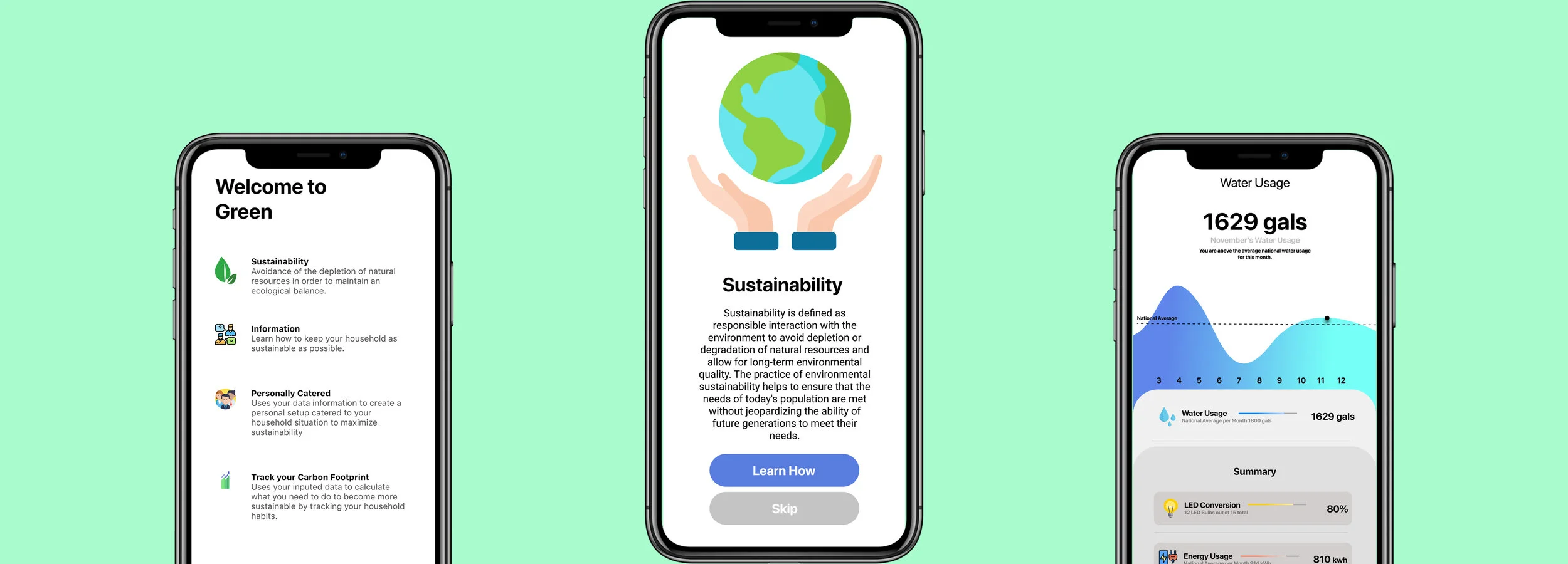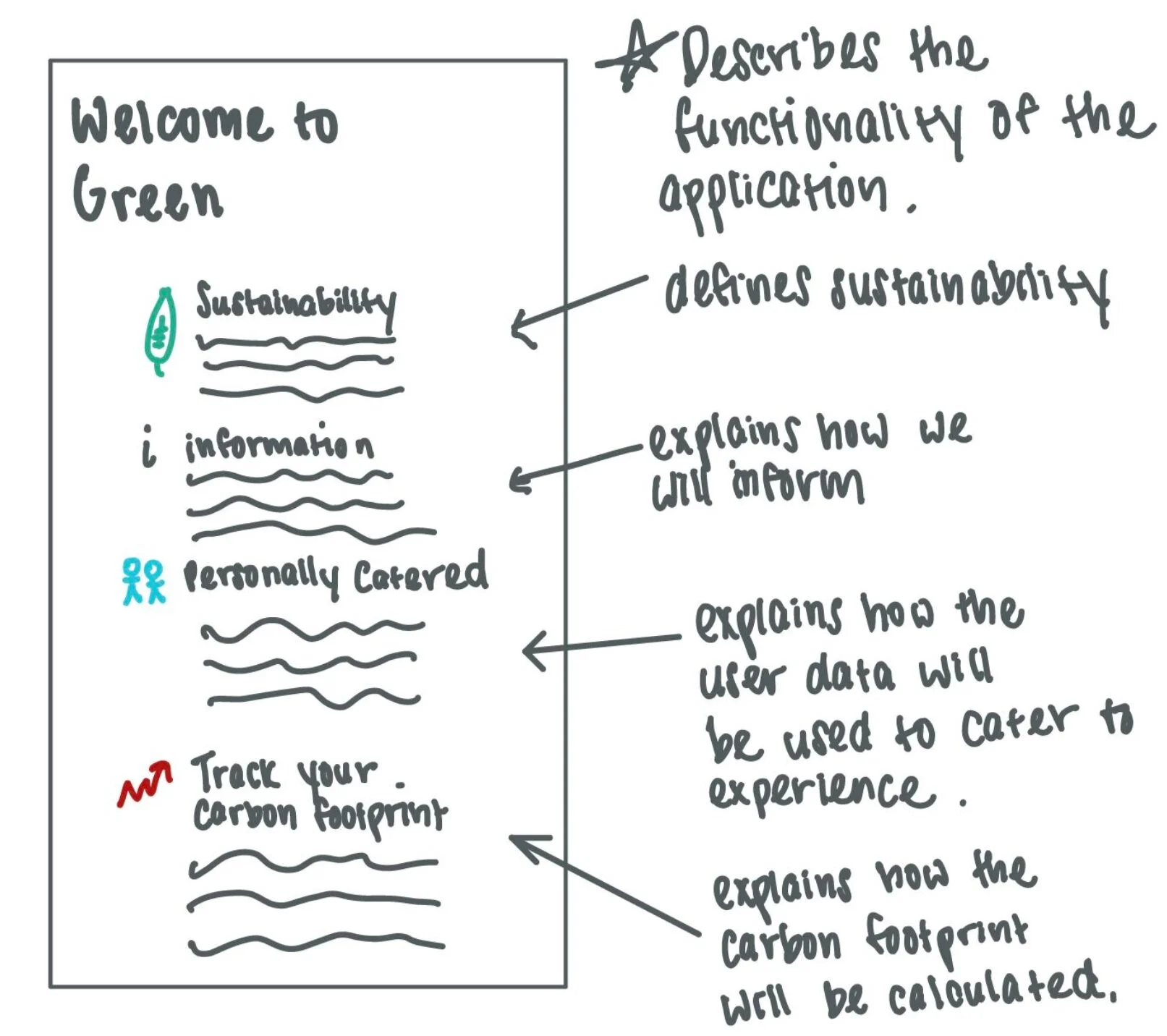A concept to maximize household sustainability.
Platform
iOS
Role
UX/UI Designer
Tool
Figma
Timeline
6 weeks
So climate change…
Our beloved Earth is experiencing negative effects from us, humans. While everyone isn’t a major contributor to world degradation, we can start cleaning up the Earth right within our households. The idea of this app is to inform users and make creating a sustainable household easier. The goal of this design is to help the overall negative repercussions of pollution, overuse, and unsustainable practices that impact the environment every day.
How might we improve sustainability within households?
Spread awareness of the current state of our planet
Inform users of how to become more sustainable
Create a personalized experience for users based on their household information
Help users calculate how sustainable their household is
Assist users in tracking sustainable habits
Understanding the lack of sustainable practices
To begin to understand the rationale behind this issue, my team and I conducted a survey and a couple of interviews. We really wanted to figure out if people were even interested in sustainability within their households, and if not, why not? We needed to know the thought process of potential stakeholders to be able to come up with effective solutions.
Do you care how sustainable your household is?
The first question’s purpose was to determine whether people even cared about the sustainability of their households. Our survey showed that 71.9% of people do care about how sustainable their households, deducting that motivation to be sustainable is not a primary issue.
Do you know how to create a sustainable household?
This time we asked whether people knew how to create a sustainable household. 50% of people didn’t know how to.
By these surveys, people care about sustainability. The issue lies in the fact that much of society is naive when it comes to sustainable practices and don’t know how to be sustainable.
Considering our options
We were tasked to create a solution for an issue that we were passionate about. We weren’t restricted to just digital products so a few solutions we considered were:
We initially considered a website. We noted a website is universal, it could be accessed from any device with a browser. Additionally, since a website is generally accessed from a larger display such as computers, we thought it may provide more screen space for information.
Next, we considered a smart device, such as a thermostat or shower head that relays information to a central app about utility usage. Advantages of it included convenience for users as they do not need to input information as it directly relays to an app.
Finally, we considered a mobile app. The mobile app would provide in pocket access to information regarding sustainable practices.
After considering our potential solutions we decided to choose a mobile app approach. Since most people use smartphones nowadays, a mobile platform would provide quick and easy access for users. A website could be beneficial but that would require a user to log onto a browser. Additionally, a smart device is too costly and would only be effective if the user had multiple smart devices calculating their usage.
How can we use an app to promote household sustainability?
Inform
Since many people lack the knowledge in creating a sustainable household, the first thing that we have to do is inform and teach our users how to be sustainable. We planned for our mobile app to include informative panels, displaying common sustainable practices within households and pushing daily tips.
Personalize
This application is will also prompt the user for data about their household and where they zip. This data will create an experience catered to their region and household. An example of this is that a user lives in a dorm. Therefore, they don’t have access to their water bills. The app will suggest practices outside of water usage. This allows for an experience that is designed to ensure that there are no intangible suggestions.
Monitor Activity
This application will also track and calculate how sustainable the user have been for a set period of time. For example, a user may use a certain amount of water in the month of November. This application will compare it to the state average tell the user to use a certain less amount of water. Along with that, it will calculate carbon emissions the user has produced based on electricity bills and habits around the household.
Visualization
This application will also compile all the given data and display it as a curve, showing how much of each category the user has used over the span of months. Each category will be a different color and can be selected to display a graph. There will be an overall graph determined by carbon emissions of all the other categories combined to show how sustainable the user’s household is overall.
Planning the user flow with a Sitemap
We weren’t sure how we wanted the user flow to be so created a sitemap to determine it.
Low-Fidelity Wireframes
We began sketching our ideas onto paper (Procreate). We were targeting the four major functionalities that we had described above. Here are a few of the sketches.
Onboarding Screen
The screen defines the purpose of this app and the functionality in it.
User Input / Building Type
Prompts the user to enter what type of building they live in for a personalized experience
Calculated Data Input
The next few slides will look like this, asking the user for more information to maximize personalization
Summary Screen
The page is where the majority of the user’s day lies. The screen provides a visual trend of the users utility usage. Each category can be clicked to display a new visual representation.
Biome, maximizing sustainability in households
Key Takeaways
Most of us know that sustainability is an issue we’ll be dealing with for the rest of Earth’s life. It was extremely empowering to be able to design for a cause that was targeted to help all of humanity.
Through this project, I realized the importance of identifying the rationale behind the problem. From our surveys, we were able to determine the key causes and directly ideate solutions to fix those issues.
Once again, collaboration and communication became the key to success in this design process. By splitting the work into design and research, we were able to create data-driven designs. I give credit to my teammates for finding great data that caused a lack of sustainable practices in households. We followed the typical design-thinking process. Finding an issue, researching that issue, brainstorming solutions, and then prototyping the ideas. While this is not a real application yet, the idea is to make it one. Preservation of the Earth is something that needs help; this is one small step in the right direction.














